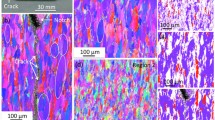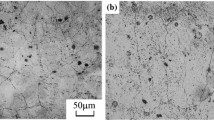Abstract
The fatigue crack growth behavior of MAR-M200 single crystals was examined at 982 °C. Using tubular specimens, fatigue crack growth rates were determined as functions of crystallographic orientation and the stress state by varying the applied shear stress range-to-normal stress range ratio. Neither crystallographic orientation nor stress state was found to have a significant effect on crack growth rate when correlated with an effective ΔK which accounted for mixed-mode loading and elastic anisotropy. For both uniaxial and multiaxial fatigue, crack growth generally occurred normal to the principal stress direction and in a direction along which ΔK II vanished. Consequently, the effective ΔK was reduced to ΔKI and the rate of propagation was controlled by ΔK I only. The through-thickness fatigue cracks were generally noncrystallographic with fracture surfaces exhibiting striations in the [010], [011], and [111] crystals, but striation-covered ridges in the [211] specimen. These fracture modes are contrasted to crystallographic cracking along slip bands observed at ambient temperature. The difference in cracking behavior at 25 and 982 °C is explained on the basis of the propensity for homogeneous, multiple slip at the crack tip at 982 °C. The overall fracture mechanism is discussed in conjunction with Koss and Chan’s coplanar slip model.
Similar content being viewed by others
References
M. D. Gell, D. N. Duhl, and A. F. Giamei: inSuperalloys, 1980, Proceedings of the Fourth Int. Sym. on Superalloys, ASM International, Metals Park, OH, 1980, pp. 205–14.
M. Gell and G. R. Leverant:Trans. AIME, 1968, vol. 242, pp. 1869–79.
G. R. Leverant and M. Gell:Trans. AIME, 1969, vol. 245, pp. 1167–73.
G. R. Leverant and M. Gell:Metall. Trans. A, 1975, vol. 6A, pp. 367–71.
D. L. Anton:Acta Metall., 1984, vol. 32, pp. 1669–79.
P. J. E. Forsyth:Proc. of the Crack Propagation Symposium, Cranfield, 1961, pp. 76–94.
M. Nageswararao and V. Gerold:Metall. Trans. A, 1976, vol. 7A, pp. 1847–55.
M. Wilhelm, M. Nageswararao, and R. Meyer:Fatigue Mechanisms, J.T. Fong, ed., ASTM STP 675, ASTM, 1979, pp. 214–33.
G. P. Van der Velde and D. A. Koss:Fatigue 84, C. J. Beevers, ed., EMAS Ltd., West Midlands, U.K., 1984, vol. 1, pp. 411–21.
J. R. Wilcox and D. A. Koss:Hydrogen Effects in Metals, TMS-AIME, Warrendale, PA, 1981, pp. 745–52.
KossD.A. and K.S. Chan:Acta Metall., 1980, vol. 28, pp. 1245–52.
D. A. Koss and K. S. Chan:Dislocation Modeling of Physical Systems, Pergamon Press, Oxford, U.K., 1981, pp. 18–22.
K. S. Chan, J. E. Hack, and G. R. Leverant:Metall. Trans. A, 1987, vol. 18A, pp. 581–91.
K. S. Chan, J. E. Hack, and G. R. Leverant:Metall. Trans. A, 1986, vol. 17A, pp. 1739–50.
B. H. Kear and B. J. Piearcey:Trans. AIME, 1967, vol. 239, pp. 1209–15.
S. M. Copley, B. H. Kear, and G. M. Rowe:Mater. Sci. Eng., 1972, vol. 10, pp. 87–92.
A.F. Giamei: Final Technical Report, Contract No. F44620-76- C-0028, Air Force Office of Scientific Research, 1979.
J. L. Yuen, P. Roy, and W. D. Nix:Metall. Trans. A, 1984, vol. 15A, pp. 1769–75.
C. A. Rau, A.E. Gemma, and G.R. Leverant: ASTM STP 520, ASTM, 1973, pp. 166–78.
G. R. Leverant, T. E. Strangeman, and B.S. Langer:Superalloys: Metallurgy and Manufacture, Claitor’s Publishing Division, Baton Rouge, LA, 1976, pp. 285–95.
A. E. Gemma, B. S. Langer, and G. R. Leverant: ASTM STP 612, ASTM, 1976, pp. 199–213.
S. W. Hopkins: ASTM STP 612, ASTM, 1976, pp. 157–69.
ASTM E-647:Annual Book of ASTM Standard, ASTM, Philadelphia, PA, 1983, pp. 710-30.
K. S. Chan and T. A. Cruse:Engineering Fracture Mechanics, 1986, vol. 23, pp. 863–74.
D. P. DeLuca and B. A. Cowles: AFWAL-TR-84-4167, 1984.
K. S. Chan:Acta Metall., 1986, in press.
M. Gell and G. R. Leverant:Fatigue at Elevated Temperature, ASTM STP 520, ASTM, 1973, pp. 37–65.
Author information
Authors and Affiliations
Rights and permissions
About this article
Cite this article
Chan, K.S., Leverant, G.R. Elevated-temperature fatigue crack growth Behavior of MAR-M200 Single Crystals. Metall Trans A 18, 593–602 (1987). https://doi.org/10.1007/BF02649475
Received:
Published:
Issue Date:
DOI: https://doi.org/10.1007/BF02649475




